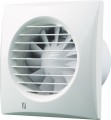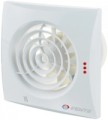Manufacturers are actively innovating in the design of this part of the device. First of all, it is worth highlighting the various materials of execution, each of which has its advantages. And in particular, cheaper, but
plastic covers of various shapes, stylish and strict
metal covers, elegant and sophisticated
glass covers(
plexiglass is also found) and, of course, exclusive
wooden ones. More details about each:
— Plastic. Plastic covers are easy to process at the production stage and are inexpensive. At the same time, plastic is quite durable and practical. Such surfaces can be given almost any shade and colouring, due to which there is a wide variability of exhaust fans with a plastic cover. The disadvantages of this material include perhaps relatively low strength and sensitivity to scratches. However, such problems are rarely encountered due to the peculiarities of the placement of extractor fans.
— Stainless steel. Stainless steel is a high-strength material that resists scratches and looks stylish and rich. The stainless steel covers increase the reliability of the extractor fan housing and allow it to harmoniously fit into a modern interior. There are design options as a solid sheet of stainless steel and panels with decorative perforations. Metal covers are usually expensive,
...so there are relatively few such models. The vast majority of them belong to the premium class and are intended for interiors of the appropriate level.
— Glass. Glass covers are a design highlight of the design of extractor fans. This material is easy to clean and does not give in to scratches, has a shiny gloss or has a discreet matte structure. Glass covers in extract fans can be painted in a variety of colours, which allows you to choose the right model for the interior design concept of the room. Glasses for the front panel are often made tempered — there is no need to worry about the fragility of this material.
- Wood. Quite a rare material for exclusively decorative purposes. Such covers are harmoniously combined with interiors in a certain style — for example, with wooden walls, rooms in an "eco" design, baths or saunas. However, from a practical point of view, they do not have advantages over the same plastic ones but are noticeably more expensive. Today, wooden covers are rather exotic, designed for principled adherents of natural materials.
- Plexiglas. A more advanced and durable analogue of plastic. Plexiglas usually have a translucent glossy finish with a characteristic sheen in the light. As a rule, such panels are made monophonic. They best fit in with the minimalist interiors of the premises. This option can be found in models of a strong middle level and top class.
— Aluminium. This material can be attributed to a confident middle class: aluminium is lightweight, has high strength, and is characterized by durability and resistance to corrosion. In addition, aluminium can be easily polished at the production stage, which simplifies the manufacturing process of aluminium covers. Extractor fans with such a front panel look stylish and expensive.Mounting depth of the fan with a standard installation method.
This parameter describes how deep into the duct the unit (or its parts in the case of surface-mounted models, see "Type") is placed during installation. Knowing the mounting depth, it is possible to assess the suitability of the selected model for a particular installation location: a flat section at the very beginning of the duct must be no less than the installation depth of the selected fan.
The smallest value of this parameter is typical for some overhead models of fans: in them, the main part of the structure is outside, and usually, only 2-3 centimetres are required for installation. And most of all, hidden units require space (see "Type").

